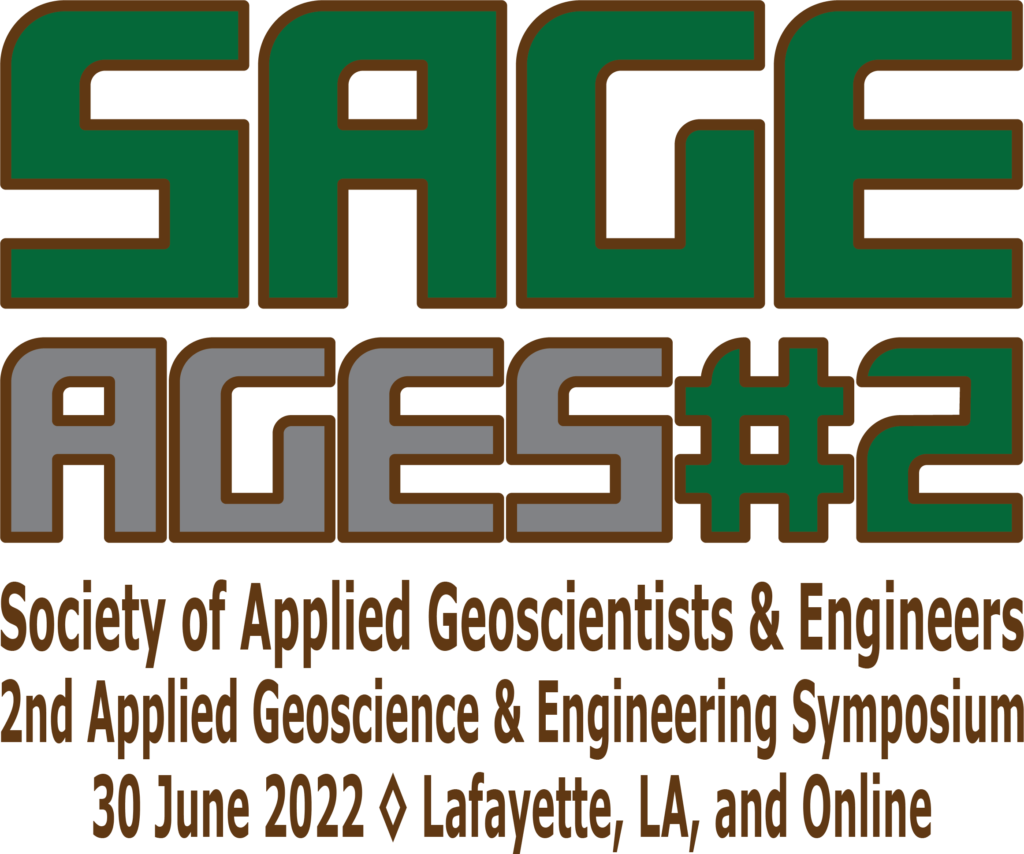2nd SAGE Applied Geoscience and Engineering Symposium (SAGE AGES #2), 30 June 2022, Lafayette, LA, and Online
SAGE AGES #2
The SAGE Acadiana Chapter hosted the 2nd SAGE Applied Geoscience & Engineering Symposium (SAGE AGES #2) on 30 June 2022 in Lafayette, LA, and Online, and included a great lineup of keynote presentations over a diversity of topics (see below for final speaker list). The event was held at the Petroleum Club of Lafayette with buffet lunch included (fried shrimp, corned beef, and another entrée selection, multiple vegetable selection, salad bar, and dessert selection) and a closing happy hour with two complimentary cocktails.
On-demand content made available by speakers will be released to the general SAGE membership in August.
$40/$30 In-Person (with/without cocktails for members and non-members), $10 Virtual (members), and $20 Virtual (non-members).

Schedule of Activities
Offshore Room, 2nd Floor, Petroleum Club of Lafayette, 111 Heymann Blvd, Lafayette, LA 70503
8:30 am: Registration Opens
9:30 am – 10:20 am: Scott Lapierre (Shale Specialists, LLC, Houston, Texas), Translating PVT Data into a First-Principles Predetermination of Recovery Factor
10:30 am – 11:20 am: Christopher M. Smith, Timothy M. Smith, Patrick S. Gordon, and Michael P. Smith (Advanced Hydrocarbon Stratigraphy, Tulsa, Oklahoma), Rock Volatiles Stratigraphy Analysis of Helium in 60+ Year Old Cores from the Keyes Dome Field in Oklahoma: Implications for Helium Exploration and Development
11:20 am: Lunch Service Begins
12:00 pm – 1:00 pm: LUNCHEON PRESENTATION: Clare Falcon (State Geologist of Louisiana and Director, Louisiana Geological Survey, Baton Rouge, Louisiana), Title TBA
1:15 pm – 2:05 pm: Deborah Sacrey (Auburn Energy, Weimar, Texas), Paradise Machine Learning Technology—Understanding the Subsurface in Detail
2:15 pm – 3:05 pm: John R. Dribus (Dribus Geologic Consulting, LLC, Mandeville, Louisiana), Overview of the Exploration History and Geology of the Guyana-Suriname Deepwater Play
3:15 pm – 4:05 pm: Chris McLindon (McLindon Geosciences, LLC, Mandeville, Louisiana), Venice Dome, South Louisiana
4:05 pm – 5:30 pm: Happy Hour Event (move to The Grille, 1st Floor of Petroleum Club)
Abstracts and Biographies are provided below.
Sponsorship
GOLD SPONSORS
Travis A. Helms

SILVER SPONSOR

List of Presentations with Abstracts and Biographies
KEYNOTE PRESENTATION: Overview of the Exploration History and Geology of the Guyana-Suriname Deepwater Play
John R. Dribus (Dribus Geologic Consulting, LLC, Mandeville, Louisiana)
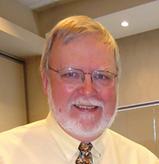
This presentation looks at the recent exploration history and geology of the deepwater Guyana Basin, offshore Guyana and Suriname and its conjugate basin across the Atlantic in west Africa. We begin with an overview of the exploration histories of the Exxon Guyana Liza and Apache Suriname Kwaskwasi areas (now at well over 10 billion barrels of recoverable oil in over 20 discoveries in Guyana, and five in Suriname). Included is a brief geologic evolution and exploration history of the Atlantic margin focusing on the plate tectonic events, sequence stratigraphy, and resulting depositional processes that created the source, reservoir, and seals in this area. The talk concludes by looking at and exploration approach that examines the key risks of the Guyana Basin plays.
BIOGRAPHY: John Dribus is a Global Reservoir Geologist and Advisor who retired from Schlumberger in 2018, and established Dribus Geologic Consulting, LLC. He has over 40 years of experience as a sedimentologist and exploration geologist, and specializes in deepwater depositional systems, below-salt plays, petroleum systems analysis, deepwater geologic hazards, and geologic training and development. His current areas of focus include the Gulf of Mexico, Guyana and Suriname, and Trinidad and Tobago. He initiated his career as a uranium field geologist in the American West. After five years, he worked in the Gulf of Mexico for 18 years for Mobil Oil Corporation, and then the next 18 years as a Global Geologist for Schlumberger. He received the Reservoir Description and Dynamics Award from the Society of Petroleum Engineers in 2013. In 2017, he was recognized by the American Association of Petroleum Geologists (AAPG) as a Heritage Geologist, and received the 2017 Best Technical Paper of the Year Award for the New Orleans Geological Society. In 2019, he received the A. I. Levorsen Memorial Award at the Gulf Coast Association of Geological Societies Convention.
SYMPOSIUM LUNCHEON PRESENTATION: Louisiana Geological Survey: Past, Present, and Future
Clare Falcon (State Geologist of Louisiana and Director, Louisiana Geological Survey, Baton Rouge, Louisiana)

The Louisiana Geological Survey has a long history. This presentation will include:
- A brief look back at the Survey of the past,
- Information on the current state of the Survey,
- Aspirations for the future of the Survey and insights into the strategy of how we will achieve it, and
- An open discussion and invitation for the audience to participate in communicating their needs and aspirations of the Survey.
KEYNOTE PRESENTATION: Translating PVT Data into a First-Principles Predetermination of Recovery Factor
Scott Lapierre (Shale Specialists, LLC, Houston, Texas)

Optimal well spacing and stimulation intensity maximizes recoveries per well, per acre, and per capital dollar while minimizing negative offset well interactions. With climate concerns prioritized, an ideal development also minimizes the consumption of natural resources and the amount of atmospheric CO2 released from producing each barrel of oil. Abundant horizontal oil production from unconventional reservoirs reveals widespread premature transition to Boundary-Dominated Flow (BDF) relative to published estimates assuming late-life BDF transitions. The resulting overcapitalization has minimized economic returns and maximized the CO2 generated from superfluous diesel-fueled drilling & completion activity. The provided workflow closes the model-measure-optimize loop for sustainable development.
The combined works of Clarkson and Qanbari, Jones, Khoshghadam et al., and Lapierre suggest that transitions to BDF in unconventional oil reservoirs are initiated upon average reservoir pressure dropping below bubblepoint and imply that oil and pore-volume compressibilities provide primary pre-bubblepoint reservoir drive energy. Intuitively it should follow that pre-bubblepoint oil recovery factors (RF) may be predetermined from first principles using PVT data independent of oil-in-place (OIP) or production information.
RFs for 2 Permian multi-well pads with historical transitions to BDF manifest in production are derived & combined with low uncertainty OIP to determine Recoverable OIP (ROIP). Cumulative oil recovered at known BDF transition is compared to the novel derived ROIP.
The oil recoveries at bubblepoint predetermined by combining PVT–based recovery factors with low-uncertainty OIP agree with the observed cumulative oil barrels produced upon onset of actual BDF transition to within +/-10% when 100% stimulation efficiencies are assumed (with stimulation efficiency equal to [recovered oil] divided by [recoverable OIP]). Economic returns and CO2 release per oil barrel are estimated for the programs ‘as-is.’ The actual well spacing and stimulation intensities employed on the two disparate Permian development units are combined and used to recommend new well spacing and stimulation intensities to achieve the same 100% stimulation efficiency with maximized economic returns and minimized amounts of atmospheric CO2 released per recovered barrel.
Traditionally, recovery factors have only served as a reactive parameter used only to ‘sanity check’ claimed oil recoveries relative to claimed OIP. The derivation of recovery factor from PVT using first principles may provide the industry with a novel proactive tool to improve the economic and environmental performance of horizontal unconventional oil development. Furthermore, the novel definition of [Recovery Factor] as being equal to [Recovered Oil] divided by [Predetermined Recoverable Oil-in-Place] may serve to enhance the optimization of both well spacing and stimulation intensities.
Additionally, known recovery factors at known recovered oil volumes combined with low-uncertainty OIP provide a novel tool for predetermining how far to offset an existing, standalone legacy producer.
BIOGRAPHY: Scott Lapierre has served in various roles in his 25 years of service to the upstream oil and gas industry.
After receiving his BS in geology from the University of South Alabama, Scott went to work for Halliburton in 1995 as a Field Engineer operating subterranean measurement equipment for drilling operations. In 2005 he joined ConocoPhillips in 2005 as a petrophysicist and began a transition from data ‘gatherer’ to ‘interpreter’.
At the dawn of the shale revolution in 2007, Scott began developing new measurement and modeling techniques for quantifying the hydrocarbon content of shales. In 2009 he joined Pioneer Natural Resources where he was instrumental in instigating their corporate transition to shale oil development via horizontal drilling.
In 2014, he cofounded PCORE, a private equity-backed E&P company designed to exploit competitive interpretation and prediction capabilities to identify shale acreage with the highest performance potential in the Permian’s Wolfcamp formations.
In 2016, after divesting PCORE to Parsley Energy, Scott founded Shale Specialists and began offering interpretations to large and small operators and equity providers. In 2017, Scott authored a controversial article on LinkedIn forewarning of unanticipated gas production and limitations to shale oil recovery that could spell trouble for the industry. Even though Scott’s predictions were validated in 2019 by a series of articles in the Wall Street Journal that clearly illuminated the shale industries inability to meet expectations, Scott’s work remains vigorously and passionately refuted by the industry.
KEYNOTE PRESENTATION: Venice Dome, South Louisiana
Chris McLindon (McLindon Geosciences, LLC, Mandeville, Louisiana)
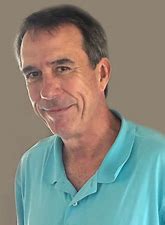
Excerpt from published article: Many have wondered about the network of canals and slips southwest of Venice, Louisiana, that boaters and fishermen call “the wagon wheel.” The outer canal forms an almost perfect circle. These canals and slips were dredged in the 1950s and 60s as drilling operators explored their way around the edges of a circular salt stock. This pillar-like body of salt is called the Venice Dome. It is not only nearly perfectly circular, but its sides are also nearly perfectly vertical along much of its length. This certainly appeared to be the case to drillers who penetrated the flanks of the dome to depths of about 12,000 feet. A subsurface structure map on the C6 Sand at Venice Field shows the outline of the salt stock. The concentric contours, which are crossed by a network of faults, indicate a structural anticline in the sedimentary layers around the dome. Sand layers which dip upward toward the salt stock are terminated by the faults or the salt creating perfect traps for the accumulation of oil and gas. Unlike some salt domes where the oil is found across the crest of the dome, at Venice the reservoirs are all trapped around the edges of the circular salt stock—hence the circular network of canals.
Venice Dome is a part of a linked tectonic system of faults and salt domes that underlies the Mississippi River delta. The major faults in the tectonic system all extend to the surface. The network of surface fault traces connect the domes and outline the eastern edge of the Terrebonne Trough. The Venice Dome is intersected by one of the major faults that dips northwestward toward the center of the trough.
…
BIOGRAPHY: Chris McLindon was employed as an exploration geologist in the oil and gas industry between 1980 and 2020. He received a B.S. in Geology from the Louisiana State University in 1979. Chris has worked for several companies in the New Orleans area including Stone Energy, McMoRan Exploration, and Helis Oil, as well as being self-employed for several years. Chris is currently the manager/member of McLindon Geosciences, LLC in Mandeville, LA. He is a past- president of the New Orleans Geological Society and a member of the Geological Society of America, the American Geophysical Union, and the Society of Independent Professional Earth Scientists. Chris was named to an oversight position for the Louisiana Coastal Geohazards Atlas Project by Dr. Charles Groat of the Louisiana Geological Survey in 2018. In that same year, he was the recipient of the Gulf Coast Association of Geological Societies Statesmanship Award in recognition of work associated with the atlas project.
KEYNOTE PRESENTATION: Paradise Machine Learning Technology—Understanding the Subsurface in Detail
Deborah Sacrey (Auburn Energy, Weimar, Texas)

Multi-attribute machine learning using self-organized mapping (SOM) (which is an unsupervised learning process) can be shown to reveal details in the data not previously identified and which can be interpreted to be lithologic in nature. The detail comes with the statistical analysis of the data based on information on each sample on each trace in the data. The result of this sample-based statistical analysis is that one can interpret thin-bed resolution well below conventional wavelet tuning. This, in turn, helps with highly accurate reservoir prediction when one ties the information to existing production or in the estimation of new reserves in exploration plays.
The key to the presentation is showing examples of problems in the every-day interpretation of data which can be solved by the neural analysis (classification) of multiple seismic attributes. These problems could be reservoir delineation, exploration and exploitation for new reserves, interpretation of complicated stratigraphic sequences, or basic interpretation when the data is less than optimal. Additionally, new deep learning algorithms allow the interpretation of faults in the data without having to manually pick fault segments (Figs. 1 and 2). This saves an immense amount of time for the interpreter. The fault attribute volume can then be combined with other attributes in the SOM process. The result allows the interpreter to see the faulting and the stratigraphy at the same time.
This presentation will highlight the use of SOM in thin bed environments, finding carbonate porosity, and showing examples with the result of SOM coupled with the fault attribute to capture compartmentalization of reservoirs.
BIOGRAPHY: Deborah Sacrey is a geologist/geophysicist with 45 years of oil and gas exploration experience in the Texas and Louisiana Gulf Coast and Mid-Continent areas of the US. She received her degree in Geology from the University of Oklahoma in 1976 and immediately started working for Gulf Oil in their Oklahoma City offices.
She started her own company, Auburn Energy, in 1990 and built her first geophysical workstation using Kingdom software in 1996. She helped SMT/IHS for 18 years in developing and testing the Kingdom Software. She specializes in 2D and 3D interpretation for clients in the US and internationally. For the past ten years, she has been part of a team to study and bring the power of multi-attribute neural analysis of seismic data to the geoscience public, guided by Dr. Tom Smith, founder of SMT. She has become an expert in the use of Paradise software and has over 5 discoveries for clients using multi-attribute neural analysis.
Deborah has been very active in the geological community. She is Past National President of SIPES (Society of Independent Professional Earth Scientists), Past President of the Division of Professional Affairs of AAPG (American Association of Petroleum Geologists), Past Treasurer of AAPG, and Past President of the Houston Geological Society. She is Past President of the Gulf Coast Association of Geological Societies and is a past member of the GCAGS representation on the AAPG Advisory Council. Deborah is also a DPA Certified Petroleum Geologist #4014 and DPA Certified Petroleum Geophysicist #2. She belongs to AAPG, SIPES, Houston Geological Society, South Texas Geological Society, and the Oklahoma City Geological Society (OCGS).
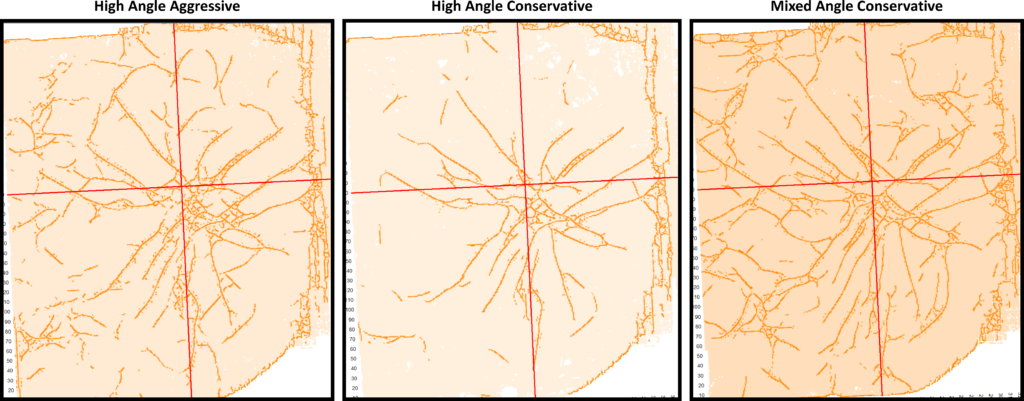

KEYNOTE PRESENTATION: Rock Volatiles Stratigraphy Analysis of Helium in 60+ Year Old Cores from the Keyes Dome Field in Oklahoma: Implications for Helium Exploration and Development
Christopher M. Smith, Timothy M. Smith, Patrick S. Gordon, and Michael P. Smith (Advanced Hydrocarbon Stratigraphy, Tulsa, Oklahoma)
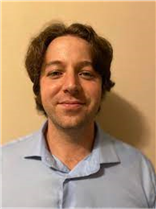
Helium has previously been listed as a critical mineral by the United States government and represents an important feedstock for critical industries and applications including aerospace, medical imaging devices, and specialty welding applications. The US has a well-developed helium infrastructure and historically good data collection which enabled it to become a predominate producer of helium; much initially based in the Oklahoma and Texas panhandles and Kansas. A major producing field and location of key infrastructure is Keyes Field in Cimarron County, Oklahoma. Wells that identified helium (≥2%) were drilled in the 1950s with off and on helium production for the next several decades. Advanced Hydrocarbon Stratigraphy (AHS) partnered with the Oklahoma Geological Survey to examine cores from the Keyes Field early in its life cycle and after a decade of production. AHS significantly improved its Rock Volatiles Stratigraphy (RVS) technology to measure sub-nanomole quantities of helium from rock samples. We report, to our knowledge, the first quantitative measurements of helium from core samples being several decades old; 69 years at time of analysis. These data are likely from the pores of the rock samples, not fluid inclusions; core from a well offset to a producing well drilled 10+ years prior shows fractionation signatures from gas production and correspondingly low helium. Additional key observations are the ability to identify low water content by RVS measurements and helium can be best preserved in “tighter” rock of poorer reservoir quality. This presents a usable workflow for RVS studies utilizing legacy samples—identifying enhanced helium responses in/below sealing features with low water content in the reservoir below the seal. Utilizing legacy materials from state surveys in Oklahoma, Kansas, and Texas has important implications for continued use of the existing helium infrastructure as fields mature and presents an important tool for future helium exploration.
BIOGRAPHY: Christopher Smith has been a Senior Chemist with Advanced Hydrocarbon Stratigraphy (AHS) since January 2019 and recently moved to Midland working on data analysis, instrumentation (including possible well stie instruments), client engagements, and business development. Most of his analysis work focuses on the North Slope in Alaska, the Delaware Basin, the Anadarko and Arkoma basins in Oklahoma, and the Marcellus. Prior to working for AHS, he received his Ph.D. in Analytical Chemistry from the University of Arizona in the Winter 2018 term with focuses on instrumentation, data analysis programing, spectroscopy, electrophysiology, surfactants, and surface modification chemistries. He also completed an M.A. in History at the University of Tulsa as a Henneke Research Fellow in 2012. He completed his undergraduate work cum laude in 2011 with degrees in Chemistry, History, and Biochemistry, also from the University of Tulsa.

